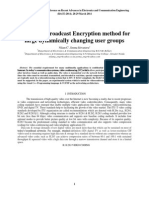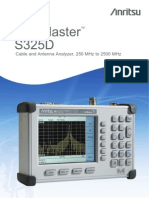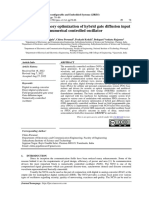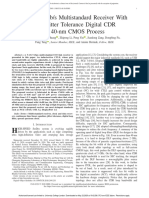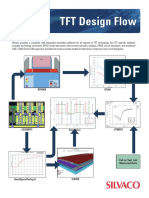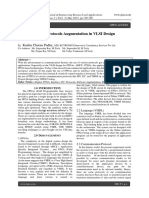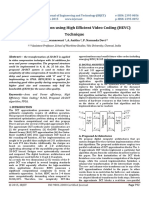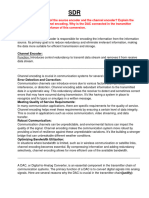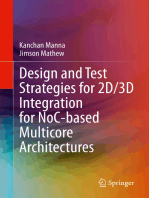0 ratings0% found this document useful (0 votes)
155 viewsPLTS 2014
PLTS 2014
Uploaded by
cgrachanenAgilent's PLTS 2014 includes novel features that will help solve real world problems. PLTS is the signal integrity industry solution for measurement and analysis of physical layer devices. Built-in customizable TX sources can be customized to match a specified signal.
Copyright:
© All Rights Reserved
Available Formats
Download as PDF, TXT or read online from Scribd
PLTS 2014
PLTS 2014
Uploaded by
cgrachanen0 ratings0% found this document useful (0 votes)
155 views25 pagesAgilent's PLTS 2014 includes novel features that will help solve real world problems. PLTS is the signal integrity industry solution for measurement and analysis of physical layer devices. Built-in customizable TX sources can be customized to match a specified signal.
Copyright
© © All Rights Reserved
Available Formats
PDF, TXT or read online from Scribd
Share this document
Did you find this document useful?
Is this content inappropriate?
Agilent's PLTS 2014 includes novel features that will help solve real world problems. PLTS is the signal integrity industry solution for measurement and analysis of physical layer devices. Built-in customizable TX sources can be customized to match a specified signal.
Copyright:
© All Rights Reserved
Available Formats
Download as PDF, TXT or read online from Scribd
Download as pdf or txt
0 ratings0% found this document useful (0 votes)
155 views25 pagesPLTS 2014
PLTS 2014
Uploaded by
cgrachanenAgilent's PLTS 2014 includes novel features that will help solve real world problems. PLTS is the signal integrity industry solution for measurement and analysis of physical layer devices. Built-in customizable TX sources can be customized to match a specified signal.
Copyright:
© All Rights Reserved
Available Formats
Download as PDF, TXT or read online from Scribd
Download as pdf or txt
You are on page 1of 25
Agilent
Physical Layer Test System (PLTS) 2014
Technical Overview
Vector Network Analyzer-based and
Time Domain Reflectometer-based Systems
Includes:
Whats New in PLTS 2014 Software
2
Whats New with with PLTS 2014?
The new Physical Layer Test System (PLTS) 2014 includes novel
features that will help solve real world problems for todays signal
integrity engineers. There are so many signal integrity tools avail-
able for design, analysis, and troubleshooting of high-speed inter-
connects its difficult to manage them all. Agilents PLTS design
team has created version 2014, integrating new features into PLTS
for a substantial boost in productivity.
PLTS is the signal integrity industry solution for measurement and
analysis of physical layer devices. Wizards help users to calibrate
and measure multiport devices with ease. Once measured, PLTS
has a rich set of displays, analysis, data reformatting and conver-
sion tools, as well as a versatile set of import and export capabili-
ties. PLTS works with PNA and ENA network analyzers, and TDRs.
Data and transmission line models can be exported to, or imported
from simulation tools. The analysis features include single-ended
and differential plots in frequency or time, as well as eye diagrams
and RCLG model extraction.
Major tool advancements
Many usability features have been incorporated into PLTS
2014, but there are two new capabilities that are considered
breakthrough for the technical industry. The first is multi-channel
simulation and the other is 1-port automatic fixture removal
(AFR). Together they create a time saving tool that helps the
experienced user accomplish more advanced analysis of the
physical layer channel.
The multi-channel simulation capability allows the user to quickly
measure a channel, remove any fixtures and then simulate the
measured channels performance. The newly added capability
to use vendor supplied IBIS-AMI models for TX and RX creates
real-world simulation results.
Built-in TX sources can be customized to match a specified sig-
nal. Users can specify data rates, lengths and voltages and then
add noise, jitter, and pre-emphasis. The built-in customizable RX
allows the user to select from the common CTLE, FFE, and DFE
equalizers. Multiple sources can be added to simulate aggressor
cross talk for multi-channel simulations. The resulting waveforms
can be displayed in multi-color eye diagrams with histograms for
common eye measurements.
The 1-port automatic fixture removal tool is a breakthrough
extension of the 2X THRU AFR that saves the user from designing
and fabricating special calibration structures on PCBs. Now, the
test fixture itself can be used as the 1X THRU structure with
an open circuit on port 2. This is extremely helpful when working
with FPGA applications where it is nearly impossible to create
a normal 2X THRU structure. Furthermore, the accuracy can be
enhanced by using additional calibration structures together such
as an open, short and/or THRU. This error correction flexibility
gives the signal integrity engineer more control over accuracy
versus ease-of-use decisions that need to be made for leading
edge applications.
Figure 1. Multi-channel simulation capability allows users to quickly
measure a channel, remove any fixtures, and then simulate the measured
channels performance using the newly added capability to use vendor
supplied IBIS-AMI models for TX and RX.
Figure 2. 1-port AFR wizard provides more control of error correction
techniques by enabling the test fixture itself to be used as the calibration
standard rather than requiring the additional 2X THRU structure to be
fabricated.
3
The next generation computer and communication systems now
being developed will handle data rates of multiple gigabits/sec-
ond. Many systems will incorporate processors and SERDES chip
sets that exceed GigaHertz clock frequencies. New and troubling
input/output issues are emerging as switches, routers, server
blades, and storage area networking equipment moving toward
10 Gbps data rates. Digital design engineers choosing chip-to-
chip and backplane technologies for these systems are finding
signal integrity challenges that have not been encountered
before.
Traditional parallel bus topologies are running out of bandwidth.
As parallel busses become wider, the complexity and cost to
route on PC boards increase dramatically. The growing skew
between data and clock lines has become increasingly difficult
to resolve within parallel busses. The solution is fast serial chan-
nels. The newer serial bus structure is quickly replacing the
parallel bus structure for high-speed digital systems. Engineers
have been turning to a multitude of gigabit serial interconnect
protocols with embedded clocking to achieve the goal of simple
routing and more bandwidth per pin. However, these serial inter-
connects bring their own set of problems.
In order to maintain the same total bandwidth as the older paral-
lel bus, the new serial bus needs to increase its data rate. As the
data rate increases through serial interconnects, the rise time
of the data transition from a zero logic level to a one logic level
becomes shorter. This shorter rise time creates larger reflections
at impedance discontinuities and degrade the eye diagram at the
end of the channel. As a result, physical layer components such
as printed circuit board traces, connectors, cables, and IC packag-
es can no longer be ignored. In fact, in many cases, the silicon is
so fast that the physical layer device has become the bottleneck.
In order to maintain signal integrity throughout the complete
channel, engineers are moving away from single-ended circuits
and now use differential circuits. The differential circuit provides
good Common Mode Rejection Ratio (CMRR) and helps shield
adjacent PCB traces from crosstalk. Properly designed differential
transmission lines will minimize the undesirable effect of mode
conversion and enhance the maximum data rate throughput pos-
sible. Unfortunately, differential signaling technology is not always
an intuitive science.
Differential transmission lines coupled with the microwave effects
of high-speed data have created the need for new design and
validation tools for the digital design engineer. Understanding the
fundamental properties of signal propagation through measure-
ment and post-measurement analysis is mandatory for todays
leading edge telecommunication and computer systems. The
traditional Time Domain Reflectometer (TDR) is still a very useful
tool, but many times the Vector Network Analyzer (VNA) is needed
for the complete characterization of physical layer components.
There is a strong need for a test and measurement system that
will allow simple characterization of complex microwave behavior
seen in high speed digital interconnects. In fact, many digital
standards groups have now recognized the importance of specifying
frequency domain physical layer measurements as a compliance
requirement. Both Serial ATA and PCI Express have adopted the
SDD21 parameter (input differential insertion loss) as a required
measurement to ensure channel compliance. This parameter is an
indication of the frequency response that the differential signal
sees as it propagates through the high-speed serial channel.
An example of a proposed SDD21 compliance mask is shown in
Figure 5 for the Channel Electrical Interface (CEI) working group
for the Optical Internetworking Forum (OIF).
Figure 3. Todays digital standards are now using frequency domain mea-
surements for compliance testing, such as this input differential insertion
loss (SDD21) mask for XAUI.
ISI Loss > 4 dB
Sample Compliance Interconnect
0 312.5 MHz 1.5625 GHz 3.125 GHz
11.4
15
S
D
D
2
1
(
d
B
)
0
Why is Physical Layer Testing Required?
4
Time-domain analysis is typically used for characterization of
these physical-layer structures, but often, the designer concen-
trates only on the intended modes of operation. For a complete
time-domain view, step and impulse responses in reflection and
transmission (TDR and TDT) must be seen. The analysis must
include the unintended modes of operation as well.
Frequency-domain analysis, again in all possible modes of opera-
tion, is also necessary for fully characterizing these physical-layer
structures. The s-parameter model describes the analog behavior
exhibited by these digital structures. This behavior includes
reflections from discontinuities, frequency dependent losses,
crosstalk, and EMI performance.
For translating device performance into standards compliance,
eye diagrams add an important statistical analysis. And for lever-
aging this complete characterization into improved simulations,
measurement-based s-parameter or RLCG model extraction
completes the picture.
Time domain Frequency domain
Mode TDR TDT Reflection Transmission
Differential TDD11 TDD21 SDD11 SDD21
TDD22 TDD12 SDD22 SDD12
Diff-to-comm TCD11 TCD21 SCD11 SCD21
TCD22 TCD12 SCD22
SCD12
Comm-to-diff TDC11 TDC21 SDC11 SDC21
TDC22 TDC12 SDC22
SDC12
Common TCC11 TCC21 SCC11 SCC21
TCC22 TCC12 SCC22 SCC12
Single-ended
T11 T21 T31 T41 S11 S21 S31 S41
T22 T12 T32 T42 S22 S12 S32 S42
T33 T13 T23 T43 S33 S13 S23 S43
T44 T14 T24 T34 S44 S14 S24 S34
Figure 5. Complete characterization includes forward and reverse
transmission and reflection, in all possible modes of operation, in both
frequency and time domains.
A single test system can provide the total view
As the combination of both time-domain and frequency domain
analysis becomes more important, the need for multiple test
systems becomes difficult to manage. A single test system that
can fully characterize differential high-speed digital devices, while
leaving domain and format of the analysis up to the designer, is a
very powerful tool. Agilents Physical Layer Test System (PLTS) is
designed specifically for this purpose.
PLTS has been designed specifically for signal integrity analysis.
PLTS software guides the user through hardware setup and
calibration, and controls the data acquisition. It automatically
applies patented transformation algorithms to present the data
in both frequency and time domains, in both forward and reverse
transmission and reflection terms, and in all possible modes
of operation (single-ended, differential, and mode-conversion).
A powerful virtual bit pattern generator feature allows a user-
defined binary sequence to be applied to the measured data to
convolve eye pattern diagrams. Next, highly accurate RLCG
1
models can be extracted and used to enhance the accuracy of
your models and simulations.
PLTS provides design condence through
complete characterization
Physical-layer structures have increasingly become the bottleneck
in high-speed digital system performance. At low data rates,
these interconnects are electrically short. The driver and receiver
are typically the biggest contributors to signal integrity. But as
clock speeds, bus speeds, and link speeds all push past the giga-
bit-per-second mark, physical layer characterization becomes
more critical.
Another challenge for today's digital designers is the trend to
differential topologies. Fully understanding device performance
requires analysis in all possible modes of operation.
1. An RLCG equivalent circuit model, also known as Telegraphers
Parameters, describes the electrical behavior of a passive transmission
line. The model is a distributed network consisting of series resistance
and inductance (R and L) and parallel capacitance and conductance
(C and G).
Single ended
Port 1
Single ended
Port 2
Single ended
Port 3
Single ended
Port 4
Differential
Port 2
Differential
Port 1
Device under test
+
Figure 4. A differential structure operates in many modes.
Single-ended analysis can reveal sources of asymmetry on this
differential transmission line.
5
Mode conversion
A practical application of how mode conversion helps identify
problems in physical layer devices is shown in Figure 9. This shows a
XAUI backplane with two daughter cards that typically transmit data
at 3.125 Gbps. The design objective for this high-speed differential
channel is to minimize the crosstalk between adjacent differential
PCB traces throughout the length of the channel. The channel
consists of the linear passive combination of the backplane and
two daughter cards. Any mode conversion from differential mode
to common mode will generate EMI and create crosstalk that will
be incident upon other channels and will degrade performance.
However, locating the exact structure within the channel that
creates the most mode conversion is not simple.
Figure 7. By aligning the impedance profile with the mode conversion
profile, PLTS allows the pinpointing of crosstalk-generating structures
within physical layer devices.
Looking at Figure 9, the differential to common mode conversion
time domain reflection parameter (TCD11) is time aligned with the
differential impedance profile of the channel (TDD11) below it. A
marker is placed on the largest magnitude peak of TCD11. This is
where the physical structure within the channel is creating the
most mode conversion and thus the source of the most crosstalk.
We can align the TDD11 to the TCD11 in time and therefore co-
locate the problematic structure on TDD11. To relate this struc-
ture to the channel, we use the differential impedance profile as a
reference. From previous analysis, we know that the two capaci-
tive discontinuities on TDD11 are the daughter card via field and
motherboard via field, respectively. Since the marker falls upon
the second discontinuity on TDD11, it is deduced that the mother-
board via field is the biggest culprit to causing crosstalk in adja-
cent channels. The motherboard via field was subsequently re-
routed and the crosstalk generation was reduced considerably.
This shows how identifying the mode conversion in a channel can
be intuitive with proper analysis.
PLTS enables mode-conversion analysis for early
insight into EMI problems
The benefits of differential signaling include lower voltage swings,
immunity from power supply noise, a reduced dependency on RF
ground, and improved EMI performance (reduced generation and
susceptibility). The extent to which a device can take advantage
of these benefits is directly related to device symmetry.
Symmetric devices only respond to, and only generate, differen-
tial signals. These ideal devices do not respond to or generate
common-mode signals, and they reject radiated external signals
(i.e., power supply noise, harmonics of digital clocks or data,
and EMI from other RF circuitry).
Asymmetric devices however, do not exhibit these benefits.
When stimulated differentially, an asymmetric device will produce
a common-mode response in addition to the intended differential
response, and cause EMI radiation. Conversely, with a common-
mode stimulus, an asymmetric device will produce an unintended
differential response. This mode conversion is a source of EMI
susceptibility.
Mode-conversion analysis is an important tool for understanding
and improving device symmetry, and provides the designer with
early insight to identify and resolve EMI problems at the design
stage.
Figure 6. Asymmetric devices cause mode-conversions, which are
indicators of EMI generation and susceptibility.
Passive differential structure
Differential
stimulus
Differential
response
Common-mode response
(unintended mode conversion)
6
Dynamic range
High-dynamic range is important for a number of reasons.
Certainly, measurements of very low levels of crosstalk are
possible, but this is only one parameter where dynamic range is
important.
More important is the ability to overcome masking effects of
multiple discontinuities, which in systems with lower dynamic
range would attenuate the stimulus such that deep structures
would become invisible.
And most importantly for differential devices, high-dynamic range
allows for identification of very low levels of mode-conversion,
which are the direct result of device asymmetry. This allows early
resolution of potential EMI issues.
Accuracy through error-correction
VNA-based systems
Four-port SOLT (Short-Open-Load-Thru)
The most common technique for both coaxial and non-coaxial
environments, SOLT calibration, is a vector error correction pro-
cess that characterizes systematic error by measuring known
calibration standards. This data is used to calculate a 72-term
error model, which is then used to remove the effects of
systematic errors from subsequent measurements.
Utilizing three impedance standards (the short, open, and load)
and a thru standard, the error model compensates for directivity,
source match, load match, reflection and transmission tracking
(frequency response), and crosstalk in both forward and reverse
directions.
Four-port TRL (Thru-Reect-Line)
TRL calibration is primarily (but not exclusively) used in non-coaxial
environments, such as in-fixture or microprobe measurements. It
determines the same error model as the SOLT calibration, although
it uses different calibration standards - a thru, a reflection standard
(a short), and one or more offset length transmission lines.
Figure 9. The vector-correction process characterizes systematic error to
provide superior accuracy in network analyzer-based systems.
TRL calibration typically provides more accuracy than SOLT and is
only available for PNA-based systems (it is not supported for
872x-based systems).
Four-port LRM (Line-Reect-Match)
LRM is a variation of TRL, and determines the same error model
as the SOLT and TRL calibrations, although it uses different (and
fewer) calibration standards a transmission line, a reflection
standard (a short), and a load.
In broadband non-coaxial environments, specifically microprobing,
LRM can offer an accuracy improvement over TRL due to band-
width limitations of the TRL line standards.
LRM calibration is only available for PNA network analyzer-based
systems (it is not supported for Agilent 872x-network analyzer
based systems).
Four-port Electronic Calibration (ECal)
For electronic calibration to 9 GHz, the Agilent N4430B ECal
Module (30 kHz to 9 GHz) is supported by all of the PLTS VNA-
based systems. With one set of connections, this solid-state tuner
simulates all of the impedance states required for full four-port
error correction with accuracy that is generally better than SOLT,
but somewhat less than TRL.
Figure 8. The PNA network analyzer-based calibration interface simplifies a
complex process, allowing full error-correction in minutes, not hours.
7
TDR-based systems
Module calibration
Module calibration, also called vertical calibration, calibrates the
gains, offsets, and timing for each channel.
At the start of the TDR calibration process, PLTS will report that
a module calibration is valid, recommended, or required.
This calibration is available for all supported TDR-based systems.
De-skew
Asymmetry in a differential system between the two step
generators, between the two receivers, etc can potentially
lead to imbalances or errors in resulting measurements.
When differential measurements are selected in the calibration
process, PLTS automatically performs this operation to remove
length variance from cables or test fixtures.
This calibration is available for all supported TDR-based systems.
Reference plane calibration (RPC)
RPC adjusts the calibration reference plane to the end of the
test cables and automatically performs the de-skew operation
(see above).
This calibration is available for all supported TDR-based systems.
Normalization
Normalization is an error correction process that characterizes
systematic error by measuring known calibration standards (a
short, a load, and a thru) to calculate an error model, which is
then used to remove the effects of systematic errors from
subsequent measurements.
The error model compensates for directivity, source match, and
reflection tracking (frequency response). This is the most
accurate calibration type for TDR.
Note: Normalization is available for the Agilent 86100 family of
oscilloscopes only.
Figure 10. Like the PNA network analyzer-based calibration interface, the
TDR-based calibration interface guides the user through the calibration(s)
reducing operator error and saving time.
8
Figure 11. PLTS has advanced error correction techniques to allow
flexibility for many applications.
Port Extension (also known as Phase Rotation) mathematically
extends the calibration reference plane to the DUT.
This technique is easy to use, but assumes the fixture the
unwanted structure looks like a perfect transmission line:
a flat magnitude response, a linear phase response, and constant
impedance. If the fixture is very well designed, this technique
can provide good results.
Because gating essentially considers the magnitude of
the unwanted discontinuity, and Port Extensions consider
phase (electrical length), using the two tools together
may provide optimum results.
Time-domain gating is similar to port extension, in that it is also
very easy and fast. The user simply defines two points in time or
distance, and the software mathematically replaces the actual
measured data in that section with data representing an "ideal"
transmission line. The return loss is then recalculated to show
the effects of the change in the frequency domain.
One practical application of time-domain gating is as a confidence
check before replacing a suspect connector.
Figure 14 illustrates how this technique might be used.
Remove unwanted effects from the measurement
Error correction
Over the years, many different approaches have been developed
for removing the effects of the test fixture from the measurement
(shown in Figure 13). The level of difficulty for each error correction
technique is linearly related to the accuracy of each method. Time
domain gating is perhaps the simplest and most straightforward
method, but it is also the least accurate. Likewise, de-embeding
is the most complicated method, but it is the most accurate. It is
important to have a test system that will allow flexibility of choos-
ing the method of error correction desired for each application.
Error correction techniques fall into two fundamental categories:
direct measurement (pre-measurement processing) and de-
embedding (post-measurement processing). Direct measurement
requires specialized calibration standards that are connected to
the end of a coaxial test cable and measured. The accuracy of the
device measurement relies on the quality of these physical stan-
dards. De-embedding uses a model of the test fixture and math-
ematically removes the fixture characteristics from the overall
measurement. This fixture de-embedding procedure can produce
very accurate results.
9
Calibration at the DUT reference plane has the advantage that
the precise characteristics of the fixture do not need to be known
beforehand, as they are measured and corrected for during the
calibration process.
An example of this technique is microprobing using a calibration
substrate, where the calibration reference plane is established at
the probe tips, rather than at the end of the coaxial test cables.
Advanced calibration techniques (TRL/LRM) originally developed
for wafer probing applications provide additional options.
Figure 14. A microprobing application, where the calibration is performed
using an impedance standard substrate, establishes the calibration
reference plane at the probe tips.
Figure 13. The effects of test fixtures can be removed from the device in
post-processing through de-embedding.
De-embedding uses an accurate linear model of the fixture, or
measured s-parameter data of the fixture. This fixture data can
then be removed mathematically from the DUT measurement
data in post-processing.
Figure 12. In this rather extreme example of time-domain gating, the top
plots show the measured differential step impedance and return loss. The
lower left plot shows a gate added to remove the large discontinuity in the
center of the trace. On the lower right, the measured and the recalculated
return losses are displayed. In this case, the gate improved the return loss
by more than 10 dB within the frequency band of interest.
10
PLTS Support for Microprobing Applications
Agilent works closely with leading microprobe and probe station
suppliers to provide the best complete system solutions possible.
One of the most significant measurement challenges is connectiv-
ity. Test equipment provides a controlled coaxial environment, but
what if the DUT the backplane, the interface connector,
the IC package is non-coaxial?
Test fixtures can provide the required connectivity, but at a
cost. The quality of the test fixture its connectors, impedance
discontinuities, parasitics, and dielectric losses all contribute
to less than ideal performance of the fixture. Subsequently,
the accuracy of the device measurement is degraded.
Several techniques are available to remove these fixture effects
(see Remove Unwanted Effects from the Measurement on page 7),
but the accuracy of these techniques is greatly impacted by the
quality of the fixture itself, or the availability of an accurate
s-parameter model of the fixture (used for de-embedding).
Microprobing can offer the user the ability to forego the test
fixture and launch the stimulus directly at the device input.
The response can be measured directly at the device output.
Additionally, when calibration substrates are available,
calibration can be performed directly at the probe tips. This
achieves co-location of the calibration reference plane with
the device measurement reference plane.
PLTS has the flexibility to accommodate many microprobe
configurations. By adding the calibration substrate coefficients
as a calibration kit, the process becomes as straightforward
as a coaxial calibration.
Figure 15. Cascade Microtechs Summit probe station.
Figure 16. GigaTest Labs GTL-4060 probe station.
11
Step 1
System setup
Step 2
Calibration
Step 3
Device
measurement
TDR
setup
process
VNA
setup
process
Setup and
calibration
complete
TDR
setup
Select calibration
and measurement
parameters
VNA
setup
TDR
calibration
VNA
calibration
PLTS Simplies the Measurement Process
Device characterization with PLTS software is straightforward.
The user interface has been designed to make setup, calibration,
and measurement intuitive and error-free. A wizard guides the
user through all of the required steps. The last prompt is to connect
the device-under-test and initiate the measurement. Setup and
calibration differs slightly between TDR-based and VNA-based
systems. However, in both cases the PLTS software provides an
intuitive wizard to assist in the step-by-step process.
Easy setup
Step 1.
In the first step, PLTS software automatically polls the GPIB,
and prompts the user to accept or modify the default parameters
based on hardware capabilities.
Figure 17. PLTS has a three-step system set up to make measurements
intuitive and error-free.
TDR setup
VNA setup
Figure 18. PLTS software completely controls the hardware setup
via GPIB.
Figure 20. Default parameters are calculated from system capabilities.
User modifications are interactive.
Figure 19. The user may calibrate only for the specific parameters of
interest. Estimated calibration times are calculated based on selections.
Parameter selection not required in the VNA setup
12
Step 3. Device measurement
For both TDR and VNA systems, when the calibration is completed,
PLTS prompts the user to connect the device-under-test, and
select an initial analysis format.
Then, the system makes all of the measurements required for the
complete characterization.
With one setup, calibration and measurement, up to sixty-four
time-domain and frequency-domain device parameters are available.
Step 2. Calibration
After the system setup, the calibration method is selected. Again,
the wizard simplifies the process and provides the greatest flex-
ibility to the user.
The calibration interface shows the required calibration standards
as icons, which are initially represented in red. As the user con-
nects the standards, and mouse-clicks the corresponding icon,
the system makes the measurement, and the icon color changes
to green (indicating completion). When all of the icons are green,
the calibration is complete.
TDR calibration
VNA calibration
Setup and calibration complete
Figure 23. All domains and formats are available immediately after the
measurement is completed.
Figure 22. The VNA system calibration wizard simplifies four-port SOLT,
TRL, and LRM error correction.
Figure 21. The TDR system calibration wizard provides status and controls
module and reference plane calibrations, de-skew, and normalization.
13
File and view management
with the data browser
Time domain analysis:
2 n
2
parameters
7 formats
time or distance
Frequency domain analysis:
2 n
2
parameters
8 formats
Format, scaling,
and marker
control with
easy access
toolbars
RLCG model extraction
2 n
2
parameters
Plot and trace
management with
context-sensitive
parameter buttons
Eye diagram analysis:
n
2
parameters
8 formats
Data analysis with n-port PLTS
14
4-port data analysis
All supported analysis types and formats are available immediately
after the measurement is completed, and at any time there after.
PLTS flexibility allows the user to begin where they are most
familiar.
Time-domain analysis
The mixed-mode time domain is a common starting point. Initially,
sixteen parameters are displayed in thumbnail view as shown
below. These thumbnails represent four modes of device opera-
tion: differential, common-mode, and the two mode-conversion
types (common-mode stimulus with differential response and
differential stimulus with common-mode response). A double
mouse-click on any of these thumbnails will expand the selected
parameter to full screen for closer analysis.
Not shown here are the additional sixteen single-ended
time-domain parameters.
Figure 24. The mixed-mode time-domain matrix.
Frequency-domain analysis
The mixed-mode frequency domain is another common starting point.
Initially, sixteen parameters are displayed in thumbnail view as
shown below. These thumbnails represent four modes of device
operation: differential, common-mode, and the two mode-conver-
sion types (common-mode stimulus with differential response
and differential stimulus with common-mode response). A double
mouse-click on any of these thumbnails will expand the selected
parameter to full screen for closer analysis.
Not shown here are the additional sixteen single-ended
frequency-domain parameters.
Figure 25. The mixed-mode frequency-domain matrix.
15
Self Resistance Self Inductance Self Capacitance
Self Conductance Mutual
Resistance
Mutual
Inductance
Mutual
Capacitance
Mutual
Conductance
Measurement-based eye diagram analysis
Using the built-in digital pattern generator, the user is able to
define virtual bit pattern (as wide as 2
32
-1 bits). PLTS then con-
volves the selected bit pattern with the device impulse response
to create an extremely accurate measurement-based eye pattern
diagram.
This eliminates the need for a hardware pulse/pattern generator,
and its flexibility allows for a great deal of "What if" analysis.
Figure 26. The digital pattern generator.
After the eye pattern is generated, marker functions can be used
to make typical measurements like jitter, eye opening, rise and fall
times, and more.
Figure 27. Eye pattern diagram.
RLCG model extraction
RLCG (resistance, inductance, capacitance, and conductance)
models describe the electrical behavior of passive transmission
lines in an equivalent circuit model.
From the measured S-parameters of a device, PLTS calculates the
R, L, C, G, complex propagation constant, and complex character-
istic impedance.
This provides a highly accurate, measurement-based coupled
transmission line model for export into modeling and simulation
software such as Agilent ADS, Synopsis HSPICE, and others.
Figure 28. RLCG model extraction (W-Element shown).
16
Frequency
N
u
m
b
e
r
o
f
c
h
a
n
n
e
l
s
4-port 50 GHz 4-port 67 GHz 4-port 18 GHz
12-port 20 GHz 12-port 50 GHz 12-port 67 GHz
4-port 20 GHz
14-port 20 GHz
N-port
8-port 20 GHz
8-port 50 GHz
4-port 40 GHz
12-port 40 GHz
8-port 40 GHz 8-port 67 GHz
PLTS Signal Integrity Solutions Portfolio
PNA-Based Examples
Below are 4-port PLTS configuration examples. For a complete list of compatible test sets go to
www.agilent.com/find/multiport. For a custom test set solution contact your local Agilent sales representative.
PLTS multiport conguration (4-port 67 GHz system)
Qty Default options Available options Description
Physical layer test system, 11 ps, 67 GHz
1 N5227A-401 10 MHz to 67 GHz vector network analyzer,
4-ports, configurable test set
4 N4421B-K67 Test port cables, 3 ft., 1.85 mm (m-f)
1 N1930B-1FP PLTS base analysis networked license
1 N1930B-3FP PLTS measurement and cal networked license
1 N1930B-5FP PLTS advanced calibration (AFR) fixed license
1 PS-S20-01 N4694A Recommended Startup Assistance
1 Option 00F 1.85 mm ECal kit
PLTS multiport conguration (4-port 50 GHz system)
Qty Default options Available options Description
Physical layer test system, 15 ps, 50 GHz
1 N5225A-401 10 MHz to 50 GHz vector network analyzer,
4-ports, configurable test set
4 N4421AK20 Test port cables, 3 ft., 2.4 mm (m-f)
1 N1930B-1FP PLTS base analysis fixed license
1 N1930B-3FP PLTS measurement and cal fixed license
1 N1930B-5FP PLTS advanced calibration (AFR) fixed license
1 PS-S20-01 Recommended Startup Assistance
1 N4693A-00F 2.4 mm ECal kit
17
PLTS multiport conguration (4-port 43.5 GHz system)
Qty Default options Available options Description
Physical layer test system, 16.5 ps, 43.5 GHz
1 N5224A-401 10 MHz to 43.5 GHz vector network analyzer,
4-ports, configurable test set
4 N4421AK20 Test port cables, 3 ft., 2.4 mm (m-f)
1 N1930B-1FP PLTS base analysis fixed license
1 N1930B-3FP PLTS measurement and cal fixed license
1 N1930B-5FP PLTS advanced calibration (AFR) fixed license
1 PS-S20-01 Recommended Startup Assistance
1 N4693A-00F 2.4 mm ECal kit
PLTS multiport conguration (4-port 26.5 GHz system)
Qty Default options Available options Description
Physical layer test system, 27 ps, 26.5 GHz
1 N5222A-401 10 MHz to 26.5 GHz vector network analyzer,
4-ports, configurable test set
4 N4419AK20 Test port cables, 3 ft., 3.5 mm (m-f)
1 N1930B-1FP PLTS base analysis fixed license
1 N1930B-3FP PLTS measurement and cal fixed license
1 N1930B-5FP PLTS advanced calibration (AFR) fixed license
1 PS-S20-01 Recommended Startup Assistance
1 N4433A-010 3.5 mm ECal kit
PLTS multiport conguration (4-port 20 GHz system)
Qty Default options Available options Description
Physical layer test system, 35 ps, 20 GHz
1 N5230C-245 4-port PNA-L network analyzer
4 N4419AK20 Test port cables, 3 ft., 3.5 mm (m-f)
1 N1930B-1FP PLTS base analysis fixed license
1 N1930B-3FP PLTS measurement and cal fixed license
1 N1930B-5FP PLTS advanced calibration (AFR) fixed license
1 PS-S20-01 Recommended Startup Assistance
1 N4433A-010 3.5 mm ECal kit
18
PLTS multiport conguration (16-port 26.5 GHz system)
Qty Default options Available options Description
Physical layer test system, 27 ps 26.5 GHz
1 N5222A-401 10 MHz to 26.5 GHz vector network analyzer,
4-port configurable test set
1 N5222A-551 N-port calibrated measurements
16 N4419AK20 Test port cables, 3 ft., 3.5 mm (m-f)
1 U3042AE12 12-port 26.5 GHz multiport test set
1 N1930B-1FP PLTS base analysis fixed license
1 N1930B-3FP PLTS measurement and cal fixed license
1 N1930B-5FP PLTS advanced calibration (AFR) fixed license
1 N1930B-7FP PLTS N-port measurement and analysis fixed license
1 PS-S20-01 Recommended Startup Assistance
1 N4433A-010 3.5 mm Ecal kit
PLTS multiport conguration (12-port 50 GHz system)
Qty Default options Available options Description
Physical layer test system, 15 ps 50 GHz
1 N5225A-401 10 MHz to 50 GHz vector network analyzer,
4-port configurable test set
1 N4421A-1CP Rack-mount kit with handles
12 N4421AK20 Test port cables, 3 ft., 2.4 mm (m-f)
1 U3045AE08 8-port 50 GHz S-parameter multiport test set
1 N1930B-1FP PLTS base analysis fixed license
1 N1930B-3FP PLTS measurement and cal fixed license
1 N1930B-5FP PLTS advanced calibration (AFR) fixed license
1 N1930B-7FP PLTS N-port measurement and analysis fixed license
1 PS-S20-01 Recommended Startup Assistance
1 N4694A Option 00F 2.4 mm Ecal kit
19
Upgrades from 2-port PNA to 4-port PLTS
Supported network analyzers
PNA
Network analyzer options
Required
System
Required
model
Required Compatible
Not tested
test set
frequency
application
number or specied
range
software
E8364A/B/C
N4421B
45 MHz to 50 GHz
E8364A/B/C 10 MHz to 50 GHz
E8363A/B/C
014 010, UNL 016, 080, 081, 083
N4420B
45 MHz to 40 GHz
N1930B
E8363A/B/C
H08, H11
10 MHz to 40 GHz
1. See software licensing sidebar on page 26.
2. PNA firmware is frequently updated. For the latest recommended firmware,
please go to http://www.na.tm.agilent.com/pna/firmware/firmware.html
PLTS Ordering Guide
PLTS system requirements
To ensure that PLTS operates effectively, your PC should have the following minimum requirements:
PLTS feature Introduced in PLTS version: Must be used with PNA version or higher:
USB ecal support for calibration in PLTS 3.0 A.04.87
Multiport Calibration in PNA 4.0 A.06.00
Query individual calibration thru types 4.2 A.07.21.00
Calibration view window 4.5 A.07.50.27
Refresh Cal 5.0
PNA-X and C models: A.08.33.13
Load Error terms 5.0
N5230A and E836xB: A.07.50.37
PNA support
2
The following are requirements for PNA Firmware. Firmware selection may depend upon the CPU.
See how to determine your CPU type. (Internet connection required.)
All PNA (E836xC) Series and PNA-L N5230C - A.09.33.09
All PNA-X (N524xA) Series - A09.33.09
All PNA (N522xA) Series - A09.33.09
All models with 1.1 GHz CPU: (E8361A, E8362B, E8363B, E8364B, N5230A) - A.07.50.48
Any model using XP on 500 MHz CPU: - A.06.04.32
Any model using Windows 2000; and all 3-port models: (N3381A, N3382A, N3383A) - A.04.87.01
In addition, some PLTS features require a later PNA firmware version.
Measurement mode ONLY Off-line analysis mode
In the lab, controlling test
equipment and making quick analysis
of the results.
In your office, performing What if... analysis,
characterization, cross-domain analysis, filtering,
waveform math, and eye diagram simulation.
CPU 1 GHz 1.5 GHz
Main memory (RAM)
512 MB - 1 GB is recommended when
measuring 16,000 points with the PNA
B-model network analyzers.
1 GB
Virtual memory - As a general rule,
virtual memory should be 1.5 to 2
times the size of main memory.
2.5 GB+ 2.5 GB+
GPIB interface
With PLTS 4.2, PLTS can
connect to a PNA over LAN
Agilent 82357A USB/GPIB Interface for
Windows or supported GPIB card
(any National Instruments or
Agilent 82340/41 or 82350 GPIB card)
No GPIB connection is required to
use PLTS off-line.
Saved (stored) measurement files can be
recalled at any time for analysis.
Operating systems
Windows XP,
Vista 32, Vista 64, and Windows 7.
Windows XP,
Vista 32, Vista 64, and Windows 7.
Screen resolution 1280 x 1024 or greater required 1280 x 1024 or greater required
Display colors High Color (16 Bit) or greater High Color (16 Bit) or greater
20
PLTS multiport test set ordering information
Test sets for use with 2-port network analyzers (E836X Family)
Model Freq Switch # Test set ports Options # Total system ports
U3024AE06 40 GHz Mechanical 6 port 700 STD (with amp) 8
U3024AE06 40 GHz Mechanical 6 port 001 BiasT 8
U3024AE10 40 GHz Mechanical 10 port 700 STD (with amp) 12
U3024AE10 40 GHz Mechanical 10 port 001 BiasT 12
U3025AE06 50 GHz Mechanical 6 port 700 STD (with amp) 8
U3025AE06 50 GHz Mechanical 6 port 001 BiasT 8
U3025AE10 50 GHz Mechanical 10 port 700 STD (with amp) 12
U3025AE10 50 GHz Mechanical 10 port 001 BiasT 12
Test sets for use with 4-port network analyzers (N5230A/C Family)
Model Freq Switch # Test set ports Options # Total system ports
U3042A E08 20 GHz Solid state 8 port 700 STD 12
U3042A E08 20 GHz Solid state 8 port 001 Amp 12
U3042A E08 20 GHz Solid state 8 port 002 BiasT/amp 12
U3042A E12 20 GHz Solid state 12 port 700 STD 16
U3042A E12 20 GHz Solid state 12 port 001 Amp 16
U3042A E12 20 GHz Solid state 12 port 002 BiasT/amp 16
U3044A Exx 40 GHz x Port Future test sets
U3045A Exx 50 GHz x Port Future test sets
Z5623AK44 20 GHz Solid state 4 port STD STD 8
Z5623AK44 20 GHz Solid state 4 port 001 Amp 8
Z5623AK44 20 GHz Solid state 4 port 002 BiasT/amp 8
Test sets for use with 2-port (E836X Family) or 4-port (N5230A/C Family) analyzers
Model Freq Switch # Test set ports Options # Total system ports
U3022AE10 20 GHz Mechanical 10 port STD STD 12 or 14
U3022AE10 20 GHz Mechanical 10 port 001 BiasT/amp 12 or 14
Note 1: The highest port count available to date is 24-ports. This is achieved by using the following configuration:
N5230C-245 (4-Port VNA)
U3042AE10 (10-Port Test Set)
U3042AE10 (10-Port Test Set)
Note 2: PLTS 5.2 is the last release that supports the legacy 8753 and 872x VNA based measurement systems. This will also be
the last release that officially supports PNA network analyzers with a CPU board < 1.1 GHz. There are currently upgrade kits
or trade-in programs to assist in upgrading or migrating these legacy instruments to a supported platform. Please contact
your local support team for more information.
21
PLTS software ordering information
Model Description
N1930B-1NP Base analysis networkable license; 1-year update subscription
N1930B-1FP Base analysis fixed license; 1-year update subscription
N1930B-1TP Base analysis transportable license (USB Key); 1-year update subscription
N1930B-3NP Measurement & cal networkable license; 1-year update subscription
N1930B-3FP Measurement & cal fixed license; 1-year update subscription
N1930B-3TP Measurement & cal transportable license (USB Key); 1-year update subscription
N1930B-5NP Advanced calibration networkable license; 1-year update subscription
N1930B-5FP Advanced calibration fixed license; 1-year update subscription
N1930B-5TP Advanced calibration transportable license (USB Key); 1-year update subscription
N1930B-7NP N-port measurement & analysis networkable license; 1-year update subscription
N1930B-7FP N-port measurement & analysis fixed license; 1-year update subscription
N1930B-7TP N-port measurement & analysis transportable license (USB Key); 1-year update subscription
Important notes regarding PLTS software conguration
1. If PLTS Studio is used (PLTS options 1NP, 1FP or 1TP), this will allow data analysis of files up to and including
4 ports (*,s4p Touchstone files). However, if data is to be analyzed from files containing more than 4 ports (for
example, 12-port data from a *.s12p Touchstone file), the appropriate PLTS multiport option must be purchased
(PLTS options 7NP, 7FP or 7TP).
2. As noted in the sample configurations on pages 16-19 of this technical overview, the VNA firmware options 550
or 551 must be ordered in conjunction with PLTS to work properly as a calibration and measurement system.
Option 550 is for applications of 4 ports or less, while option 551 is for applications greater than 4 ports.
3. PLTS option 1xP is required for either 3xP, 5xP, or 7xP options.
4. PLTS has an annual update called SUS that stands for Software Update Service. Each new PLTS license
comes with 12 months of SUS. After 12 months, a 1 or 2 year SUS must be purchased to receive technical support
and new PLTS software updates. If any SUS lapses, then a 2 year SUS must be purchased to re-activate the support
and updates.
5. Option 3xP is required for instrument control portions of option 5xP. As noted in 3 above, option 1xP is required for
either 3xP, 5xP, or 7xP options.
22
Agilent has developed a breakthrough signal integrity software
tool that enables digital interconnect designers never before
available capabilities. The Physical Layer Test System (PLTS) ver-
sion 5.2 software Option N1930B-5TP will incorporate three new
advanced calibration tools that optimize the design of high speed
connectors, cables, backplanes and printed circuit boards. The
PLTS Option N1930B-5TP provides advanced calibration wizards
for a complete suite of signal integrity capability including:
Thru-Reflect-Line (TRL) calibration wizard for design and
validation of customer-built test fixtures
Differential crosstalk calibration wizard that takes into account
coupling effects of differential transmission lines on fixtures for
extremely accurate error correction
Automatic fixture removal feature that requires only a
symmetric Thru structure is measured for quick and easy
fixture de-embedding
TRL calibration wizard
Many high-speed digital labs today must design test fixtures for
data rates above 5 Gbps. More advanced design techniques must
be used when designing test fixtures for these sensitive s-param-
eter measurements. The TRL calibration process has been the tra-
ditional method for microwave engineers for decades to precisely
locate the measurement reference plane. However this advanced
technique has been out of reach for most digital laboratories due
to complexity. This is no longer the case.
The TRL calibration wizard is the worlds first software tool that
enables the design and validation of a PCB-based TRL calibration
kit. This step-by-step process easily guides you carefully through
the normally tedious and error prone process of TRL fixture de-
sign, saving at least 50% of the design cycle time from beginning
to end, thus reducing the number of board spins. Now, with TRL
calibration wizard, you can invoke the wizard to define the line
lengths for each calibration structure. After sending the board
layout details to a PCB house for manufacture, the wizard will
measure the newly designed TRL test fixture to verify that it will
work properly at the desired high frequency range.
Figure 29. The TRL Calibration Wizard in PLTS N1930B-5TP
option is an industry rst for enabling complex vector
network analyzer error correction in an easy to use format
for PCB xtures.
Figure 30. The TRL Calibration Wizard has a step-by-step
procedure for validating the customer built TRL xture
and veri es the high frequency performance level in a
quantitative fashion.
Advanced Calibration Software Option N1930B-5xP
23
Differential crosstalk calibration wizard
When designing test fixturing for interconnect characterization, the
age old question is How should I route my test fixture transmis-
sion lines, single-ended or differential? Some engineers correctly
route them single-endedly, some erroneously route them differen-
tially and some just dont care. The biggest mistake is to route dif-
ferentially and ignore the coupling effects. As long as a calibration
algorithm is used to remove coupling effects, then this test fixture
design flaw can be easily remedied. The differential crosstalk cali-
bration wizard in PLTS 5.2 Option 5TP will automatically measure
these coupling effects and remove them from the measurement
using a proprietary calibration algorithm. Some steps in the wizard
can be eliminated if the fixture is symmetric from front to back,
thereby optimizing the algorithm in real time. There are test fixture
amplitude measurement errors as large as 25 dB that have been
fixed by the differential crosstalk calibration wizard.
Automatic xture removal
It can sometimes be a complicated process to achieve accurate
calibrations with a vector network analyzer (VNA). The time
consuming part of the measurement sequence is often not the
measurement itself, but the calibration. For those who feel that
way, we have created the Automatic Fixture Removal. There are
two ways to accomplish AFR: the legacy 2X Thru method intro-
duced in PLTS 2011 or the new 1-port open method introduced
in PLTS 2014. The legacy method is a simple process that entails
measuring a user created 2X Thru calibration PCB coupon (two
fixtures end-to-end). This 2X Thru coupon trace can be built on
test fixtures themselves or on a separate Cal board. In either case,
as soon as this measurement is input into the wizard and the total
measurement of the DUT plus fixtures is in the active window of
the wizard, then a simple click on the Apply button and the fix-
ture is accurately removed. The resultant accuracy is better than
a TRL calibration. It is simple, fast AND accurate. For PLTS 2014,
the 1-port AFR has been greatly enhanced to allow the test fixture
itself to be used as a 1-port open cal structure. This means that
AFR can now accommodate any application for high-speed signal
integrity applications.
Making VNAs easier than TDRs
It has often been stated that VNAs are extremely accurate at the
cost of being complicated. This is possibly true if the right tools
are not at your disposal. Well, now the right toolset is available at
the right time; just as data rates are driven to 5 Gbps and higher.
No longer do you need to settle for the 40 dB dynamic range of a
TDR when you have a VNA toolset that makes high dynamic range
measurements a simple task. The PLTS 2014 Option N1930B-5TP
is exactly what youve been waiting for.
Figure 31. One of the most difcult error corrections to do is
remove differential coupling in test xtures. The Differential
Calibration Wizard is the rst tool of its kind to perform a
correction to remove error due to this type of coupling.
Figure 32. Automatic Fixture Removal (AFR) is the industry standard for
de-embedding test xtures without having the xture S-parameters.
24
PLTS application software uses new licensing
capabilities. Besides fixed license and networkable
FLEXlm licensing on a shared server, there is also
a transportable USB key. The summary of the three
licensing options are as follows:
Option xFP Fixed license (default).
Fixed licenses are locked to a single PC through its host ID
(e.g., the MAC address) with or without connected system
hardware. Fixed licenses do not require any networking or
license server processes. A fixed license is also known as
a node-locked license.
Option xNP Networkable license.
Networkable licenses allow users to share a single license,
or multiple licenses, over a network. The application soft-
ware may be installed on an unlimited number of PCs with
or without connected system hardware. The number of
available licenses determines the number of concurrent
users. Networkable licenses require a license server and a
TCP/IP (or IPX/SPX) connection between clients and
server(s). A networkable license is also known as a floating
license.
Option xTP Transportable license. Transportable licenses
are locked to a USB key that can be shared among different
PCs.
Important licensing notes:
1. File import, file export, calibrations, and measurements
greater than 4 ports requires one of the following PLTS
options: 7NP, 7FP, or 7TP.
2. For 4-port calibrations option 550 is required on the PNA
firmware. For greater than 4-port calibrations option 551
is required on the PNA firmware.
3. See configuration guide information contained in this
Technical Overview for further details.
Web resources
Visit our Web sites for additional product and literature information.
www.agilent.com/find/plts
www.agilent.com/find/ena
www.agilent.com/find/pna
www.agilent.com/find/multiport
www.agilent.com/find/ecal
MATLAB is a registered trademark of
the The MathWorks, Inc.
Windows is a U.S. registered trademark of
Microsoft Corporation.
www.agilent.com
www.agilent.com/find/plts
For more information on Agilent
Technologies products, applications or
services, please contact your local Agilent
office. The complete list is available at:
www.agilent.com/find/contactus
Americas
Canada (877) 894 4414
Brazil (11) 4197 3600
Mexico 01800 5064 800
United States (800) 829 4444
Asia Pacic
Australia 1 800 629 485
China 800 810 0189
Hong Kong 800 938 693
India 1 800 112 929
Japan 0120 (421) 345
Korea 080 769 0800
Malaysia 1 800 888 848
Singapore 1 800 375 8100
Taiwan 0800 047 866
Other AP Countries (65) 375 8100
Europe & Middle East
Belgium 32 (0) 2 404 93 40
Denmark 45 45 80 12 15
Finland 358 (0) 10 855 2100
France 0825 010 700*
*0.125 /minute
Germany 49 (0) 7031 464 6333
Ireland 1890 924 204
Israel 972-3-9288-504/544
Italy 39 02 92 60 8484
Netherlands 31 (0) 20 547 2111
Spain 34 (91) 631 3300
Sweden 0200-88 22 55
United Kingdom 44 (0) 118 927 6201
For other unlisted countries:
www.agilent.com/find/contactus
(BP-09-27-13)
Product specifications and descriptions in
this document subject to change without
notice.
Agilent Technologies, Inc. 2012-2014
Published in USA, January 22, 2014
5989-6841EN
myAgilent
myAgilent
www.agilent.com/find/myagilent
A personalized view into the information most relevant to you.
Three-Year Warranty
www.agilent.com/find/ThreeYearWarranty
Beyond product specification, changing the ownership experience.
Agilent is the only test and measurement company that offers
three-year warranty on all instruments, worldwide.
Agilent Assurance Plans
www.agilent.com/find/AssurancePlans
Five years of protection and no budgetary surprises to ensure
your instruments are operating to specifications and you can
continually rely on accurate measurements.
www.agilent.com/quality
Agilent Electronic Measurement Group
DEKRA Certified ISO 9001:2008
Quality Management System
Agilent Channel Partners
www.agilent.com/find/channelpartners
Get the best of both worlds: Agilents measurement expertise and
product breadth, combined with channel partner convenience.
You might also like
- CHS Periodical Test Grade 7 & 8Document6 pagesCHS Periodical Test Grade 7 & 8Evelyn Grace Talde Tadeo76% (29)
- What Is Virtual Reality?Document40 pagesWhat Is Virtual Reality?Aftab PopatiaNo ratings yet
- Altera DDC DucDocument32 pagesAltera DDC DucgpraveenroyNo ratings yet
- Signal Intagrity Simulation of PCIE PDFDocument5 pagesSignal Intagrity Simulation of PCIE PDFvijithacvijayanNo ratings yet
- On Signal Tracing in Post-Silicon Validation: Qiang Xu Xiao LiuDocument6 pagesOn Signal Tracing in Post-Silicon Validation: Qiang Xu Xiao LiuKiran KumarNo ratings yet
- IJTech EECE 798 VLSI Circuit Optimization For 8051 MCUDocument8 pagesIJTech EECE 798 VLSI Circuit Optimization For 8051 MCUThủyBìnhNo ratings yet
- Design and ASIC Implemenatation of DUC/DDC For Communication SystemsDocument20 pagesDesign and ASIC Implemenatation of DUC/DDC For Communication SystemsAnonymous e4UpOQEPNo ratings yet
- VlsiDocument32 pagesVlsibalasaravanan0408No ratings yet
- Debug and Testability Features For Multi-Protocol 10G SerdesDocument5 pagesDebug and Testability Features For Multi-Protocol 10G SerdesvelusnNo ratings yet
- Embedded Node Around A DSP Core For Mobile Sensor Networks Over 802.11 InfrastructureDocument4 pagesEmbedded Node Around A DSP Core For Mobile Sensor Networks Over 802.11 Infrastructureb42eluNo ratings yet
- DSP Lab ManualDocument26 pagesDSP Lab ManualMadhan ReddyNo ratings yet
- DSP Techniques For Radio AmateursDocument32 pagesDSP Techniques For Radio AmateursbaymanNo ratings yet
- An Efficient Cordic Processor For Complex Digital Phase Locked LoopDocument7 pagesAn Efficient Cordic Processor For Complex Digital Phase Locked LoopInternational Journal of Application or Innovation in Engineering & ManagementNo ratings yet
- Link Budget Analysis Guide: November 21, 2014Document19 pagesLink Budget Analysis Guide: November 21, 2014Анатолий МаловNo ratings yet
- 1983-07 - HP Journal PapersDocument40 pages1983-07 - HP Journal PapersElizabeth WilliamsNo ratings yet
- Design of A High Speed Serializer, Timing Analysis and Optimization in TSMC 28nm Process TechnologyDocument6 pagesDesign of A High Speed Serializer, Timing Analysis and Optimization in TSMC 28nm Process TechnologyEditor IJRITCCNo ratings yet
- Design and Implemation of An Enhanced Dds Based Digital Modulator For Multiple Modulation Schemes Manoj Kollam, S.A.S Krishna Chaithanya and Nagaraju Kommu IJSSAN 2011Document6 pagesDesign and Implemation of An Enhanced Dds Based Digital Modulator For Multiple Modulation Schemes Manoj Kollam, S.A.S Krishna Chaithanya and Nagaraju Kommu IJSSAN 2011John JohnstonNo ratings yet
- A Software-Programmable Multiple-Standard Radio PlatformDocument5 pagesA Software-Programmable Multiple-Standard Radio PlatformdvdreadsNo ratings yet
- Communication Radar Systems Design and SimulationDocument89 pagesCommunication Radar Systems Design and SimulationAbdulrahman BastaNo ratings yet
- Design and Experimental Evaluation of A Time-Interleaved ADC Calibration Algorithm For Application in High-Speed Communication SystemsDocument12 pagesDesign and Experimental Evaluation of A Time-Interleaved ADC Calibration Algorithm For Application in High-Speed Communication SystemsRahul ShandilyaNo ratings yet
- CETCME-2020 - NIET - Vineet ShekherDocument9 pagesCETCME-2020 - NIET - Vineet Shekherडाँ सूर्यदेव चौधरीNo ratings yet
- National Channel Link II Design GuideDocument24 pagesNational Channel Link II Design Guide捷陈No ratings yet
- Tech SeminarDocument27 pagesTech SeminarNaresh KNo ratings yet
- The Novel Broadcast Encryption Method For Large Dynamically Changing User GroupsDocument8 pagesThe Novel Broadcast Encryption Method For Large Dynamically Changing User GroupsRavindra KumarNo ratings yet
- Base Band Modem Hardware Design: P. Antognoni, E. Sereni, S. Cacopardi, S. Carlini, M. ScafiDocument5 pagesBase Band Modem Hardware Design: P. Antognoni, E. Sereni, S. Cacopardi, S. Carlini, M. Scafikokome35No ratings yet
- FPGA-based Implementation of Efficient Sample Rate Conversion For Software Defined RadiosDocument5 pagesFPGA-based Implementation of Efficient Sample Rate Conversion For Software Defined RadiosNitin MathurNo ratings yet
- Site Master S325D: Cable and Antenna Analyzer, 250 MHZ To 2500 MHZDocument12 pagesSite Master S325D: Cable and Antenna Analyzer, 250 MHZ To 2500 MHZSameer SulemanNo ratings yet
- Application of Mentorgraphics Tools: Eldo PlatformDocument5 pagesApplication of Mentorgraphics Tools: Eldo Platformvijendra_415174385No ratings yet
- Can BusDocument19 pagesCan BusVipin JainNo ratings yet
- Design and Memory Optimization of Hybrid Gate Diffusion Input Numerical Controlled OscillatorDocument9 pagesDesign and Memory Optimization of Hybrid Gate Diffusion Input Numerical Controlled OscillatorIJRES teamNo ratings yet
- A Gigahertz Digital CMOS Divide-By-N Frequency DivDocument25 pagesA Gigahertz Digital CMOS Divide-By-N Frequency Divfernandodlsantos7No ratings yet
- A 5-13.5 Gbs Multistandard Receiver With High Jitter Tolerance CDR PDFDocument11 pagesA 5-13.5 Gbs Multistandard Receiver With High Jitter Tolerance CDR PDFMinh KhangNo ratings yet
- DSP System DesignDocument35 pagesDSP System DesignLokesh KumarNo ratings yet
- TFT Design Flow 08Document8 pagesTFT Design Flow 08Nikhil PuriNo ratings yet
- KatalogDocument164 pagesKatalogVien HernandezNo ratings yet
- FEC-Aided Decision Feedback Blind Mismatch CalibraDocument11 pagesFEC-Aided Decision Feedback Blind Mismatch CalibraPhuc HoangNo ratings yet
- Practical Tips On Cdma2000 1xEV-DO Forward-Link Movement: Cell MasterDocument12 pagesPractical Tips On Cdma2000 1xEV-DO Forward-Link Movement: Cell MasterMiguel Hugo PintosNo ratings yet
- Module 5 NotesDocument27 pagesModule 5 NotesbcruchithaNo ratings yet
- Iq - Link Key Features: Comsearch A Commscope CompanyDocument15 pagesIq - Link Key Features: Comsearch A Commscope CompanyShailendra GaikwadNo ratings yet
- The Concept of IEC 61850Document7 pagesThe Concept of IEC 61850reva_rkNo ratings yet
- Paper 20Document4 pagesPaper 20Mohamed AhmiedNo ratings yet
- Communication Protocols Augmentation in VLSI Design ApplicationsDocument5 pagesCommunication Protocols Augmentation in VLSI Design ApplicationsMoorthy VenkatachalamNo ratings yet
- Time Interleaved AdcsDocument8 pagesTime Interleaved Adcsmarwen_z100% (1)
- Image Compression Using High Efficient Video Coding (HEVC) TechniqueDocument3 pagesImage Compression Using High Efficient Video Coding (HEVC) TechniqueAnonymous gQOifzNo ratings yet
- Testing Int2Document10 pagesTesting Int2raghulraghul55008No ratings yet
- 1997 TCASII I. Galton Spectral Shaping of Circuit Errors in Digital To Analog ConvertersDocument10 pages1997 TCASII I. Galton Spectral Shaping of Circuit Errors in Digital To Analog Converterskijiji userNo ratings yet
- Volume 1number 2PP 508 513Document6 pagesVolume 1number 2PP 508 513Anubhav SinghNo ratings yet
- Esign Hapter Pdates: A, M - S RF S DT T CDocument5 pagesEsign Hapter Pdates: A, M - S RF S DT T Cochie_loverNo ratings yet
- Wcdma ThesisDocument5 pagesWcdma Thesisezhj1fd2100% (2)
- Full Custom Design Flow For A Transimpedance Amplifier Using Cadence VirtuosoDocument6 pagesFull Custom Design Flow For A Transimpedance Amplifier Using Cadence VirtuosoRajasekar PanneerselvamNo ratings yet
- A 500 MHZ GaAs Digital RF' Memory Modulator ICDocument4 pagesA 500 MHZ GaAs Digital RF' Memory Modulator ICAjinkya KaleNo ratings yet
- Channel EncoderDocument45 pagesChannel Encodersurajsinghssd5No ratings yet
- A Reconfigurable Time Multiplexed Multichannel ADC Model For Efficient Data AcquisitionDocument4 pagesA Reconfigurable Time Multiplexed Multichannel ADC Model For Efficient Data Acquisitionaakashbari.ec20No ratings yet
- RTL Compiler PDFDocument49 pagesRTL Compiler PDFStudent100% (1)
- Debugging Serial BusesDocument40 pagesDebugging Serial Busessatian_aNo ratings yet
- Unit 3 System Interfacing and ControllersDocument48 pagesUnit 3 System Interfacing and ControllersSrinivasan V PNo ratings yet
- High-Performance 8-Bit Modulator Used For Sigma-Delta Analog To Digital ConverterDocument7 pagesHigh-Performance 8-Bit Modulator Used For Sigma-Delta Analog To Digital ConverterAmeya DeshpandeNo ratings yet
- Automated Measurement of Frequency Response of Electrical Networks Filters and AmplifiersDocument7 pagesAutomated Measurement of Frequency Response of Electrical Networks Filters and AmplifiersDiscrete ComponentNo ratings yet
- VLSI Design of Low Power High Speed 4 Bit Resolution Pipeline ADC in Submicron CMOS TechnologyDocument13 pagesVLSI Design of Low Power High Speed 4 Bit Resolution Pipeline ADC in Submicron CMOS TechnologyAnonymous e4UpOQEPNo ratings yet
- Design and Test Strategies for 2D/3D Integration for NoC-based Multicore ArchitecturesFrom EverandDesign and Test Strategies for 2D/3D Integration for NoC-based Multicore ArchitecturesNo ratings yet
- Software Radio: Sampling Rate Selection, Design and SynchronizationFrom EverandSoftware Radio: Sampling Rate Selection, Design and SynchronizationNo ratings yet
- The Standard 8 Dec06Document66 pagesThe Standard 8 Dec06cgrachanenNo ratings yet
- The Standard Jun06Document22 pagesThe Standard Jun06cgrachanenNo ratings yet
- This Is An Optical Illusion..Document43 pagesThis Is An Optical Illusion..cgrachanenNo ratings yet
- The Standard Summer 01Document40 pagesThe Standard Summer 01cgrachanenNo ratings yet
- Standard Vol14-No3 (2000)Document46 pagesStandard Vol14-No3 (2000)cgrachanenNo ratings yet
- Standard Vol13-No3 (1999)Document47 pagesStandard Vol13-No3 (1999)cgrachanenNo ratings yet
- Risk Based ThinkingDocument10 pagesRisk Based Thinkingnorlie0% (1)
- The Slow Frog An Intraday Trading Strategy: A Rules Based Intra-Day Trading Strategy (Ver 1.0)Document17 pagesThe Slow Frog An Intraday Trading Strategy: A Rules Based Intra-Day Trading Strategy (Ver 1.0)ticman123100% (1)
- Phase 1 BaruDocument66 pagesPhase 1 BaruSriramNo ratings yet
- Mtle ScoresDocument3 pagesMtle Scoresapi-296788592No ratings yet
- Mastering The Super Timeline Log2timeline StyleDocument43 pagesMastering The Super Timeline Log2timeline StyleOluseyi AkindeindeNo ratings yet
- Cronbach's AlphaDocument4 pagesCronbach's AlphaRobert RodriguezNo ratings yet
- Tractor Ergonomics: TO - Er. H S DhingraDocument14 pagesTractor Ergonomics: TO - Er. H S DhingraRohit SainiNo ratings yet
- Creativity For StudentDocument3 pagesCreativity For StudentElianna MelnikNo ratings yet
- (BS en 20286-1 - 1993) - IsO System of Limits and Fits. ISO System of Limits and Fits. Bases of Tolerances, Deviations and FitsDocument50 pages(BS en 20286-1 - 1993) - IsO System of Limits and Fits. ISO System of Limits and Fits. Bases of Tolerances, Deviations and FitsKeo Dính Chuột100% (1)
- Compression Control Problem # 1: C NB F PDocument8 pagesCompression Control Problem # 1: C NB F PPaulo Roman RamirezNo ratings yet
- Optimise Hydrocracker Operations For Maximum DistillatesDocument8 pagesOptimise Hydrocracker Operations For Maximum Distillatesdantorrelio89No ratings yet
- Higher Order Thinking Skills (HOTS) Questions: Grade 10: ScienceDocument3 pagesHigher Order Thinking Skills (HOTS) Questions: Grade 10: Sciencesahil ahmed100% (2)
- IBM VIOS MaintenanceDocument46 pagesIBM VIOS MaintenanceEyad Muin Ibdair100% (1)
- Distributed FunctionsDocument510 pagesDistributed FunctionsnivasvNo ratings yet
- Simon InternDocument38 pagesSimon InternMarvin kakindaNo ratings yet
- Template CHN DutyDocument7 pagesTemplate CHN DutyKrissel Tisha LopezNo ratings yet
- Misconduct in The Banking Superannuation and Financial Services IndustryDocument13 pagesMisconduct in The Banking Superannuation and Financial Services Industryজয়দীপ সেনNo ratings yet
- ISC Home Science SyllabusDocument7 pagesISC Home Science SyllabusDhruv ErryNo ratings yet
- Multi-Level Adaptive SolutionsDocument58 pagesMulti-Level Adaptive SolutionscubewormNo ratings yet
- Assignment 1Document1 pageAssignment 1kush ganatraNo ratings yet
- Sap MagDocument6 pagesSap MagakunooNo ratings yet
- Oral Presentation Rubric: Sample Oral Presentation Rubric: CategoryDocument2 pagesOral Presentation Rubric: Sample Oral Presentation Rubric: CategoryRavenkay SamsonNo ratings yet
- Request Letter January PDFDocument1 pageRequest Letter January PDFJennifer JavierNo ratings yet
- Kenza Salmi's Essay "Nepotism in Algeria"Document3 pagesKenza Salmi's Essay "Nepotism in Algeria"nour edhoha100% (4)
- 2.news Presentation FormatDocument11 pages2.news Presentation Formatteff_ssfNo ratings yet
- AS CB VI Math RQB 3Document7 pagesAS CB VI Math RQB 3Bala Raghavendra PrasadNo ratings yet
- Public Affairs Manager Job DescriptionDocument3 pagesPublic Affairs Manager Job DescriptionHerlis OlmosNo ratings yet























